When you are given an opportunity to go whale watching in Tofino you take it. With 20,000+ gray whales migrating past Tofino during the spring, there is a great chance you will be able to see gray whales feeding of off the beaches, mudflats or sandy bottom areas.
With Adam and I living in Tofino, we knew we would need to get out and see the gray whales. In our travels, we have seen minke, pilot, and humpback whales and we wanted to add gray whales to the list. Neither of us had seen a gray whale and we also had never been out on the water since living in Tofino. My sister and niece were visiting, so we knew this would be a perfect opportunity for all of us to go whale watching in Tofino to see the gray whales.
Early Wake-Up Call
Our adventure started at 6:45 am as we had to be Jamie’s Whaling Station at 8 am. I looked at the marine forecast and I wondered if we would be able to go as there was a gale warning in effect. At 7:30 am I called Jamie’s Whaling Station and Stephanie let me know that we were good to go as the winds would be picking up later in the day.
After breakfast, my sister Beth, my niece Elise and I headed off to Jamie’s Whaling Station. Adam would be meeting us there since he had been working through the night as an extra for an ABC pilot tv show called “The Crossing.”
All Aboard the Pacific Springs
After signing a standard waiver, we went down to the docks where we boarded the Pacific Springs, a 35-foot cabin cruiser boat. The boat sat 12 which was thankfully cozy and warm since it was chilly outside. After a talk about safety and putting on our personal flotation devices, we were on our way to find some whales and other wildlife.
The first thing we spotted were buoys in the water dotting all around which we learned were crab traps. All around the crab traps were different gulls flying around looking for something to eat.
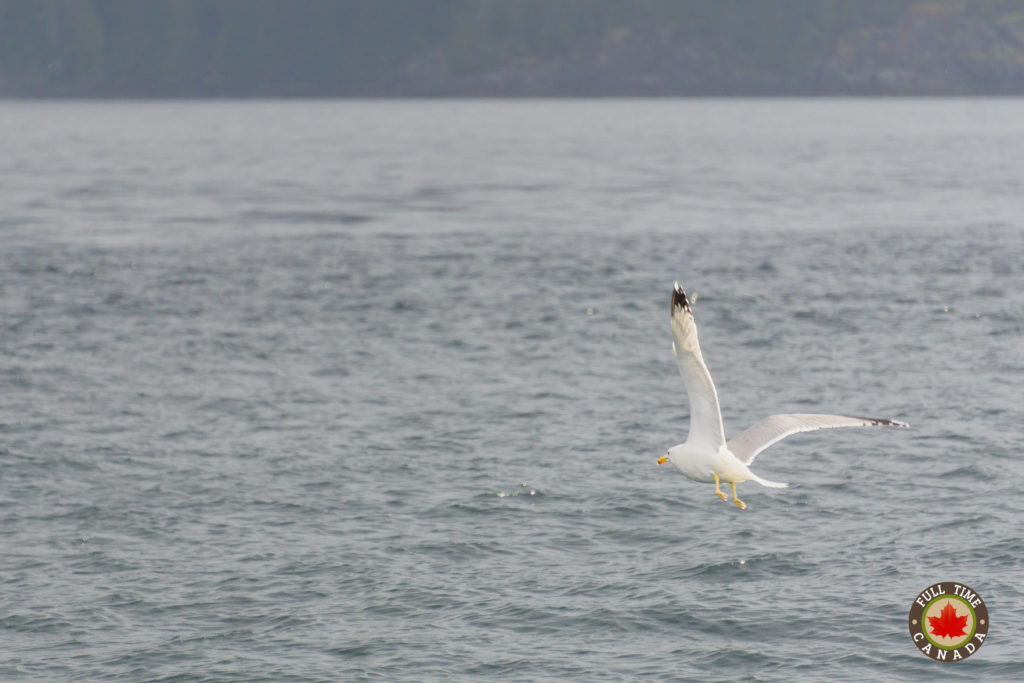
A gull looking for something tasty to eat.
The captain of the boat – Chris McCue started explaining the sights to us and indicated that British Columbia is the 2nd largest crab producer in the world. Captain Chris also pointed out Opitsaht on Meares Island which is a community of the Tla-o-qui-aht people of the Nuu-chah-nulth First Nation. They live in one of the oldest settlements on the Vancouver Island as some say it was 10 thousand years ago that the Tla-o-qui-aht people arrived as the ice was first receding.
Spotting an Otter
As we went along the smooth waters of the inlet, we could see Surf Scooter Ducks with beautiful Lone Cone Mountain as a backdrop. Captain Chris has sharp eyes and spotted a sea otter bobbing in the water in front of Cat Face Mountain. He explained how otters are incredibly smart and are one of the few animals to use a tool to eat. They will carry a rock in the pit of their leg and use it to smash open sea urchins.
The pelt of otters are also the thickest of any mammal which helps keep them warm in the chilly waters of the Pacific Ocean. Their pelts are also incredibly soft. Because of the softness and the warmth of the pelts, sea otters were hunted to extinction along the West Coast in the 1800’s. Later, the sea otters were re-introduced into the area by humans and can now easily be spotted around the Tofino boat docks and within Clayoquot Sound.
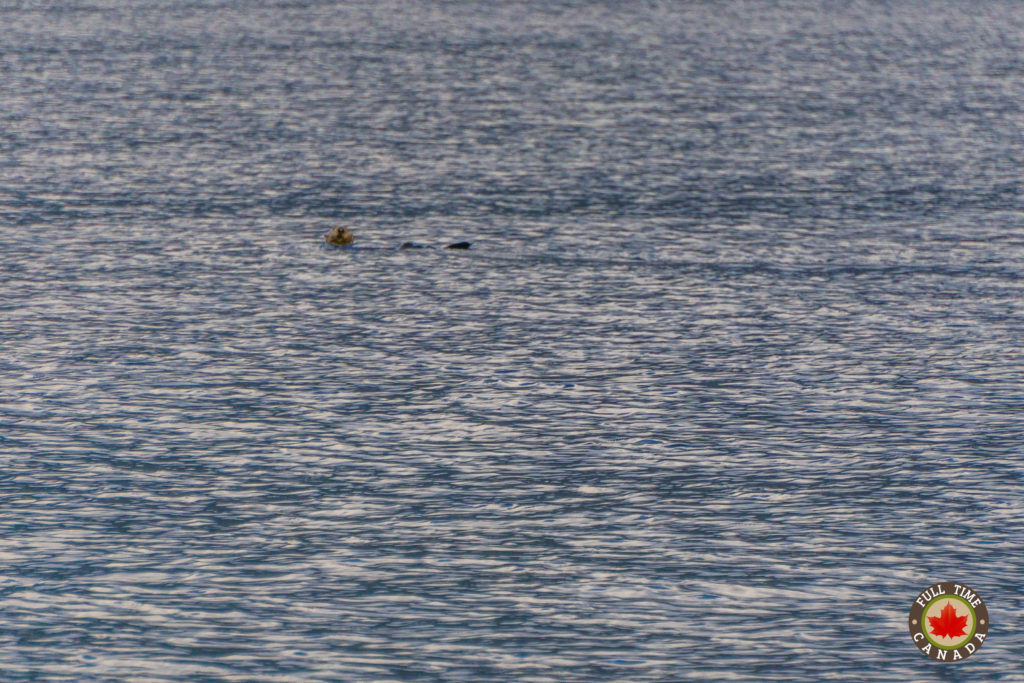
A sea otter playing around.
Geoducks
Captain Chris also pointed out Geoduck Boats (pronounced Gooey Ducks). Geoducks are the largest burrowing clams in the world. There is a huge market for them in China where they are considered a delicacy and an aphrodisiac. Divers go down and dig them out of the seabed. Geoducks are one of the longest-living animals of any type with a lifespan of up to 140 years.
Bald Eagles
As we motored along, Adam spotted a bald eagle that was drying its wings on a rock. We stopped close by so everyone could get photos. Even though we frequently see bald eagles in Tofino, we never get tired of seeing them. They’re so beautiful. While we were watching the first eagle drying its wings, we noticed another eagle flying towards us from a nearby island.

Bald eagle sitting on a rocky island drying out.
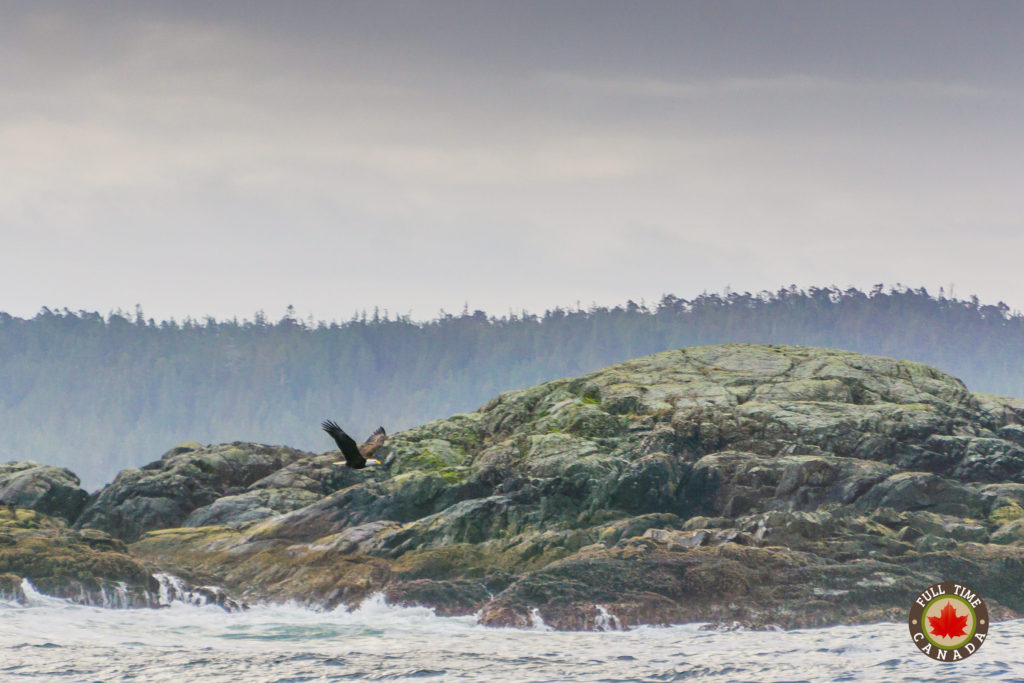
A bald eagle taking off from a rocky island.
Trying to Find a Gray Whale
After watching the eagles for a few minutes, Captain Chris was informed by one of the local boats passing by that there was a gray whale over by Clifford’s Point. Since we were almost there, he slowed right down and we all had our eyes on the water. Right at that point, it started to hail as large black clouds threatened to downpour on us. Then all of a sudden the sun broke through the clouds and there was a nice rainbow.

A rainbow arching over Clayoquot Sound.
As we continued to look for the whale, I went out on the deck of the boat where Adam already was trying to spot the gray whale. A woman who was on the boat spotted the whale’s spout first and we saw the tail come up a bit. The whale then dove down and disappeared before we were able to get a good peek.
As we inched closer to the whale, Captain Chris advised us that when the gray whale goes down to feed, it would take about 5 minutes before coming up for another breath of air. Sometimes they will dive down for as long as 20-minutes. Deckhand Jeremy Randall was standing out on the deck and told us how gray whales don’t find food based on sight or smell. Instead, they dive down and blindly take a taste to see if there is anything worth eating.
As we waited, I looked all around us. The mountains were gleaming in the sunshine. I also looked at the houses that were across the water at the Ahousaht First Nations on Flores Island.

Houses of the Ahousaht First Nation on Flores Island.
Gray Whale Fun Facts
-According to the World Wildlife Federation, gray whales have a hump and a ridge of sharp bumps along their backs, instead of a dorsal fin.
-Adult gray whales can be as long as 15 metres and weigh up to 35 tonnes. Stack five male African elephants onto a scale and you get the picture. Female gray whales are slightly bigger than males.
-Gray whales are a type of baleen whale, which means they filter food from the water through special bristly structures in their mouths.
-Gray whales stay close to shore and feed in shallow water. Their well-known migrations take them between feeding and breeding areas, swimming as much as 12,000 miles round trip. It’s one of the largest migrations of any mammal on earth. The Gray Whales mate and have their calves in the warm winter waters of Mexico. They then make their way up the coast in the spring, stopping in British Columbia to eat before continuing on to the Bering, Chukchi, and Beaufort Seas.
The Whale Reappears
After five minutes, close by we spotted a spout shoot through the air. Captain Chris told us that whale spout smells horrible. Whales have a protective oil on their lungs that rots and when they discharge it, it smells terrible.
The gray whale slowly floated on top of the water before diving down once again. We moved around for about half an hour watching this one whale as it floated up and dove down. Every time the whale dove down, we didn’t know where it would reappear. Whales will continue to move around in search for good food. When the whale did reappear it was never near the boat and we would have to reposition the boat to get a bit closer. It was like a game of hide-and-seek on the water.
Throughout the time watching the gray whale, it rarely breached its tail. It also never entirely breached its body. The one thing everyone wants to see when whale watching in Tofino is a whale completely launch itself out of the water. Captain Chris said that gray whales rarely do that and publications like National Geographic make everyone think it’s something common to see.
Heading Back to Tofino
After viewing the gray whale, we made our way back to Tofino. Unfortunately, due to the gale warning, we couldn’t go out on the open ocean to see more whales as the water would be too rough.
Captain Chris continued to tell us more stories including the most interesting things he had seen out on the sea. The biggest spectacle being 500 dolphins feeding along with 3 humpback whales.
Captain Chris pointed out Vargas Island and told us to watch along the beach for coastal wolves which are often seen hunting. He also explained how feral cows roam around on Meares Island. European settlers would push them off the boats and round them up on the beach but some would get loose and happily live wild on the island. He said the meat and milk would taste odd as they wild cows eat a lot of sea kelp.
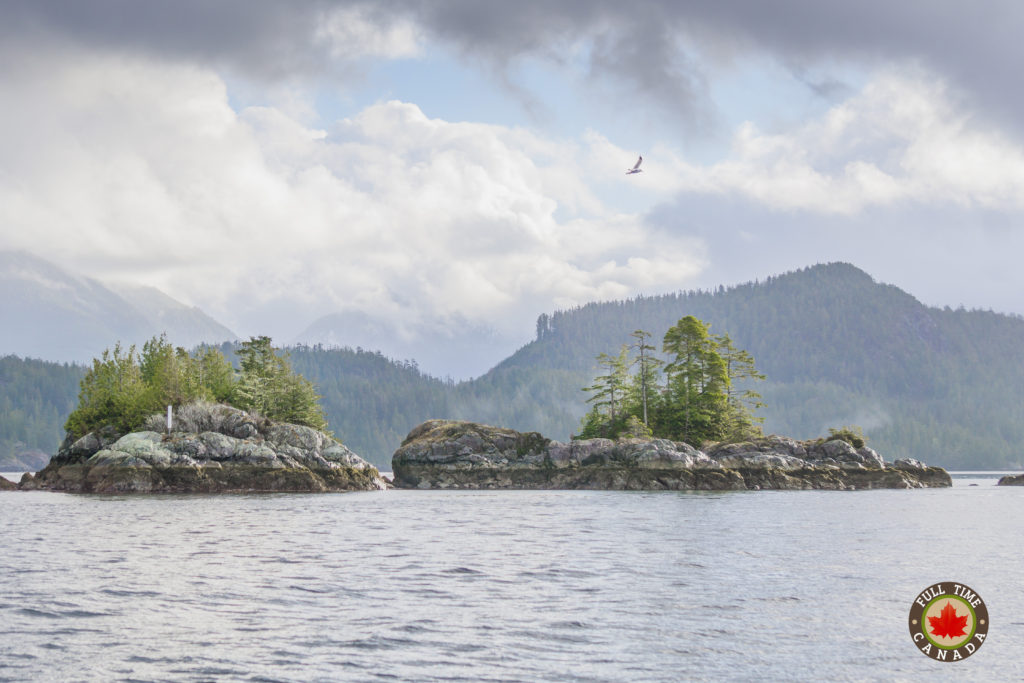
Some of the small island in Clayoquot Sound as we made our way back to Tofino.
Strawberry Isle Marine Research Society
As we arrived at the docks we learned about the Strawberry Isle Marine Research Station. When you go whale watching in Tofino with Jamie’s there is a $3 research fee that goes to the Strawberry Isle Marine Research Society. The research station is very important to Clayoquot Sound. They conduct research of the marine ecosystems, monitor marine life and promote public awareness of the marine environment in Clayoquot Sound. People who go whale watching in Tofino have donated over a million dollars to fund their work.
Back On Land
In total, the tour was 3 hours long, but the time flew by as Captain Chris from Jamie’s Whaling Station had many great stories to share and educated us on the area. If you’re planning to go whale watching in Tofino, this is a trip well worth taking, not only to see whales but to learn about the history of the area.
Upon arriving back at the dock, we were starving and Adam was also falling asleep after being up for over 24-hours. We knew that Jamie’s also owned the Jamie’s Rainforest Inn which has a great restaurant. So, we drove to the restaurant and had some of their homemade waffles which was the perfect way to end the adventure.

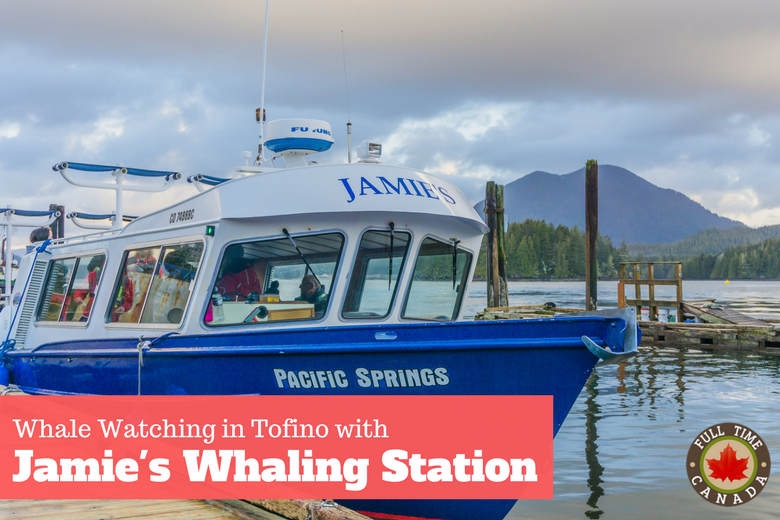

6 comments
We had a great time in Tofino and Jamie’s whale tour was one of the highlights. Very professional, fun and informative. Thanks so much Kate and Adam.
Great post! I never give up an opportunity to go whale watching! I love that you never know what to expect or know what you are going to see. Thanks for sharing your experience. This is definitely something I will save for a later trip.
Bummer that you did not get to see more of the whale – but regardless how awesome is it to see animals in their natural habitat? Animals are not there for our entertainment so any sight of them is such an honour! Sounds like you saw some cool other animals too. 🙂
You’re exactly right about the animals being in their natural habitat and not being there for our entertainment. It is special just being able to see them do their thing without their safety or comfort being compromised.
Shame you never saw more whales, I do love whale watching always, it’s always good to spend the day out at sea and even better when there are whales. My daughter loves killer whales most but also all other whales and I think she would love it here. Think I might have to take her.
Yeah – we were hoping to see more whales but we still had a great time. We’re on the lookout for Orcas as we haven’t seen them in the wild yet.